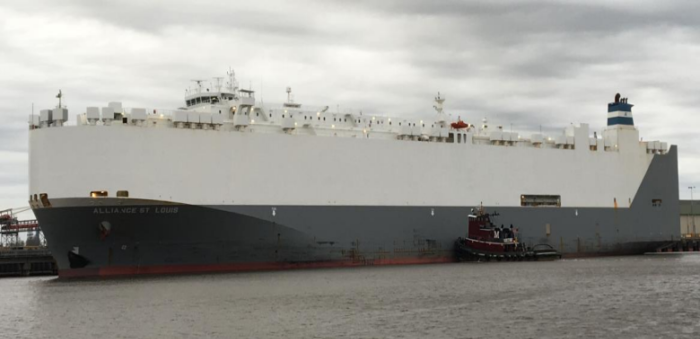NTSB released a report about the fire onboard the vehicle carrier Alliance St. Louis. The vessel had began from Port Arthur, Texas, heading to Jacksonville, Florida, when a pipe plug on the fuel pump for the main engine’s no. 6 cylinder came loose, causing fuel spray onto the engine’s hot exhaust gas pipe manifold. The atomized fuel ignited, causing fire. The fire was contained to the main engine room and extinguished by the CO2 fixed fire-suppression system. No injuries were reported.
The incident
Early on January 16, the Alliance St. Louis’s main engine’s low fuel oil inlet pressure alarm sounded. Shortly after, the engine room alarm activated on the bridge and in the engineering officers’ staterooms, followed by the vessel’s fire-detection system. Moments later, the ship lost power to the main propulsion and steering systems. The emergency diesel generator automatically started and came online, providing power to essential equipment and the steering system.
The bridge crew activated the general alarm on the bridge and crewmembers reported to their emergency stations. The chief mate and the chief engineer went to investigate the spaces that the problem was reported in, while two fire teams prepared the firefighting gear. The chief mate saw thick black smoke exiting from the ventilation louvres filling with smoke. The crewmembers then closed the engine room ventilation dampers and control stops to prevent the spread of smoke and reduce the supply of oxygen. They also shut the fuel and lube oil quick-closing valves to cut off potential fuel sources to the fire.
The master decided to extinguish the fire using the engine room’s CO2 firefighting equipment. The crew released CO2 into the engine room, each time accounting for all persons ahead of time. After the third release, the engine room temperatures decreased and then stabilized.
[smlsubform prepend=”GET THE SAFETY4SEA IN YOUR INBOX!” showname=false emailtxt=”” emailholder=”Enter your email address” showsubmit=true submittxt=”Submit” jsthanks=false thankyou=”Thank you for subscribing to our mailing list”]
The crew’s timely and effective use of the CO2 firefighting equipment lprevented the spread of the fire and minimized the extent of damage to the engine space.
The pipe plug was probably not torqued enough into the top cover during the last inspection because the crew did not recognize this as a crucial step in maintaining the reliability of the fuel oil system. The instruction book’s section Overhaul of Top Cover Complete played a role to the crew’s lack of awareness about this dangerous situation because it did not depict the fuel oil return passages or describe the purpose of the pipe plugs.
Probable cause
The National Transportation Safety Board determined that the probable cause of the engine room fire aboard the Alliance St. Louis was improper tightening of a pipe plug on the top cover of the no. 6 cylinder fuel pump housing, which caused high-pressure release of marine gas oil. Another cause of the fire was the wrong attachment of a fuel spray shield to the top cover, which allowed fuel to spray directly onto the cylinder’s hot exhaust pipe and ignite.

See the full report about the accident on the PDF herebelow
































































